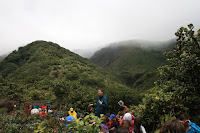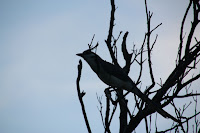In Costa Rica we traveled through many types of forests and we were able to identify some of them, like the dry forests. Dry forests are located in tropical and subtropical latitudes, have a dry and warm climate and seasonal droughts.
 |
| Perfect example of dry forest in dry season. |
In dry forests the annual precipitation is enough to allow the growth of trees but the long drought seasons because the trees to develop especial characteristics that help them survive in the hard periods. For example, deciduous trees lose their leaves to store more water and survive; some types of trees that use this strategy are Teak trees and mountain ebony. Because this strategy is very useful deciduous trees are the ones mostly found in dry forests. Other types of trees commonly found in the dry forests are evergreen trees. These trees have roots so long that can reach underground water and so can have water at all times without needing to lose their leaves. The last types of trees are the bushes. These small trees survive thanks to the protection of other trees from the sun in dry seasons. And in rainy seasons when the large trees are still recovering sunlight reaches them and gives them nutrients that help them grow.
 |
| Dry forest going to secondary succession. |
When all Nogales was walking through a dry forest, we all noticed that it was all gray and brown and that the trees and other plants were dead. Later, we were said that the forest was once burned because people that were forbidden to hunt burned it as revenge. The forest was going through succession. Which kind of succession? Secondary succession because the forest is re-growing on land.
The dry forests on Guanacaste (national park where students stay on Costa Rica) are inhabited by lots of animals. Several animals are beautiful, and others are dangerous. There are 136 species of birds in which 16 are considered rare, threatened, or in extinction danger. Various birds in the dry forest of are the toucan, the yellow-napped parrot, and the white-tipped dove.
There are some dangerous animals at Guanacaste, but no one should worry. Animals like pumas, jaguars, and ocelots live in this place. As everyone knows, this animals are carnivores and they had attacked people in some cases, but they don't attack humans often. They are nocturnal and they ambush their prey. To ambush means to be sneaky and silent at the time of hunting, they don't let their prey see them before they hunt it. Because they ambush, they will never attack such a big group of people together so they will never attack the people of Los Nogales. Other carnivores are the fox and the ferret. They won't hurt people.
Other interesting animals are the monkeys. There are lots of these mammals at Guanacaste like the white faced monkey and the howling monkey. Every morning, at the first camp, all Nogales awakened with the howling of howling monkeys. The sound was like "u u, u u, u u" and all the people felt anger and uncomforted when this specie awakened us in the morning with a kind of annoying sound. We could never see them but I, Laura Boada, imagine them as big, hairy monkeys with oval shaped mouths, howling and jumping from tree to tree and branch to branch in the mornings.
In the transition from humid forest to dry forest, as all the people went back to the camp after a tired day, we heard something. We heard the sound of tree branches moving so we looked up and we saw a herd of white faced monkeys. I, Mateo Vargas Osorio, felt excited because I had never seen such a big number of monkeys at the same time. They had a white face, and part of their trunk was also white, the rest of their body was all black and they had black eyes. The monkeys jumped from branch to branch making them move. There was a female monkey that was carrying her baby, it was amazing. Everyone was silent, anyone wanted to scare the monkeys and make them jump and climb away. That day I learned that the other half of the forest is above us.
 |
| I saw something like this but bigger. |
Some animals in the dry forests are the tapir and the ant bear. When I, Olga Lucia Vives, was on the beach I recognized that there was a dry forest some meters away. For example, the bathrooms were located in that little forest. When I was washing my food dishes (nearby the forest) I saw a strange animal in front of me. It was small and made no sound, but it was scary at the beginning, but then I calmed down I saw the animal again. This time, I saw the animal as unique and beautiful. As I looked it carefully, I realized that the characteristics of that animal were similar to the ones of a tapir, but it wasn't a tapir because it was smaller.
 On the little tropical dry forest, I also saw a giant iguana. It was impressing! That iguana was twice the size than a normal one. When the people saw the iguana, some of them were scared, but others, like me, were impressed and left the iguana alone, because it was starting to get scared. I felt amazed. The iguana was big and green, and had a big, fat face. Its body was large and finished in a long green tail. The iguana made no sound and walked slowly.
On the little tropical dry forest, I also saw a giant iguana. It was impressing! That iguana was twice the size than a normal one. When the people saw the iguana, some of them were scared, but others, like me, were impressed and left the iguana alone, because it was starting to get scared. I felt amazed. The iguana was big and green, and had a big, fat face. Its body was large and finished in a long green tail. The iguana made no sound and walked slowly.Rodents that inhabit the dry forests are the mice and the squirrels. Some mice called "ratónes de sechura" in Spanish are special mice that are adapted to extreme heat, so the heat of the dry forest is not a challenge for them. We were not able to see them, but saw another rodent that is the squirrel. At the same time as we all saw the herd of white faced monkeys, there were squirrels jumping and walking on the trees. They were small and brown. We all felt excited because we saw monkeys, but at the same time we saw beautiful, fast, and silent squirrels.
There are a lot of insects in the tropical dry forests of Guanacaste. Mosquitoes, scorpions, and bees are some of the many insects that live in these forests. These animals (except the mosquitoes) won't bite anyone if they don't bother them or their home. Mosquitoes bit to get your blood. To avoid them, you should use a lot of repellent.
The dry forests that we experienced were beautiful and unique…enjoy them!
Olga Lucia Vives, Mateo Vargas Osorio, Laura Boada Robayo
 Also in Costa Rica the people help more than here to preserve the environment and the natural reserves. You can prove this by watching the proportions of the amount of natural parks in Colombia and the amount in proportion of national parks in Colombia. Think this Colombia is 20 times bigger than Costa Rica and it have 10 natural reserves and natural parks. And Colombia that is 20 times bigger only have 32 so think if you have in 1/20 of Colombia 10 national parks that's a lot. The conclusion is basically that Costa Rica have 10 parks per each 1/20 part of Colombia. A lot! But Costa Rica has not only blue flag beaches there is a second award given by this organization the blue flag marine. This flag is awaeds the marines that are clean and have special coral riffs, animals and marine plants Costa Rica also have 11 flags of those.
Also in Costa Rica the people help more than here to preserve the environment and the natural reserves. You can prove this by watching the proportions of the amount of natural parks in Colombia and the amount in proportion of national parks in Colombia. Think this Colombia is 20 times bigger than Costa Rica and it have 10 natural reserves and natural parks. And Colombia that is 20 times bigger only have 32 so think if you have in 1/20 of Colombia 10 national parks that's a lot. The conclusion is basically that Costa Rica have 10 parks per each 1/20 part of Colombia. A lot! But Costa Rica has not only blue flag beaches there is a second award given by this organization the blue flag marine. This flag is awaeds the marines that are clean and have special coral riffs, animals and marine plants Costa Rica also have 11 flags of those.


























